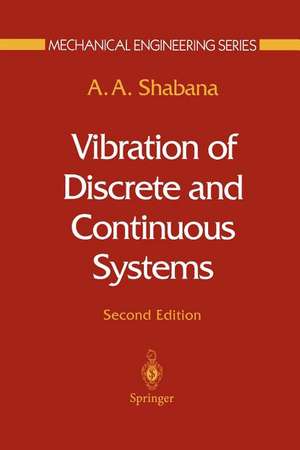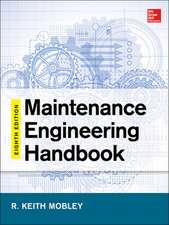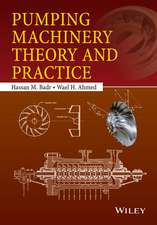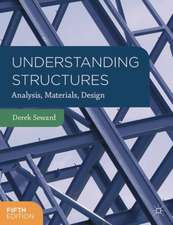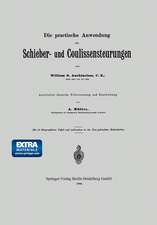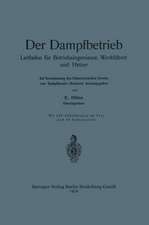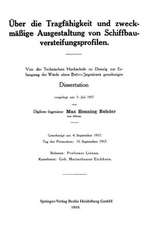Vibration of Discrete and Continuous Systems: Mechanical Engineering Series
Autor Ahmed Shabanaen Limba Engleză Paperback – 26 sep 2011
| Toate formatele și edițiile | Preț | Express |
|---|---|---|
| Paperback (1) | 590.58 lei 38-45 zile | |
| Springer – 26 sep 2011 | 590.58 lei 38-45 zile | |
| Hardback (2) | 620.73 lei 38-45 zile | |
| Springer International Publishing – 16 oct 2019 | 620.73 lei 38-45 zile | |
| Springer – 13 dec 1996 | 653.00 lei 6-8 săpt. |
Din seria Mechanical Engineering Series
-
 Preț: 391.84 lei
Preț: 391.84 lei - 18%
 Preț: 1110.72 lei
Preț: 1110.72 lei - 15%
 Preț: 593.73 lei
Preț: 593.73 lei - 18%
 Preț: 944.99 lei
Preț: 944.99 lei - 15%
 Preț: 653.14 lei
Preț: 653.14 lei - 17%
 Preț: 363.13 lei
Preț: 363.13 lei - 18%
 Preț: 1239.05 lei
Preț: 1239.05 lei - 15%
 Preț: 640.06 lei
Preț: 640.06 lei - 18%
 Preț: 1129.65 lei
Preț: 1129.65 lei - 15%
 Preț: 522.24 lei
Preț: 522.24 lei - 15%
 Preț: 654.77 lei
Preț: 654.77 lei - 15%
 Preț: 643.34 lei
Preț: 643.34 lei - 15%
 Preț: 611.40 lei
Preț: 611.40 lei - 18%
 Preț: 765.96 lei
Preț: 765.96 lei - 20%
 Preț: 631.71 lei
Preț: 631.71 lei - 18%
 Preț: 1009.22 lei
Preț: 1009.22 lei -
 Preț: 418.34 lei
Preț: 418.34 lei - 15%
 Preț: 640.71 lei
Preț: 640.71 lei -
 Preț: 403.53 lei
Preț: 403.53 lei - 18%
 Preț: 813.97 lei
Preț: 813.97 lei - 18%
 Preț: 1386.48 lei
Preț: 1386.48 lei - 18%
 Preț: 951.47 lei
Preț: 951.47 lei - 18%
 Preț: 833.09 lei
Preț: 833.09 lei - 18%
 Preț: 936.60 lei
Preț: 936.60 lei - 15%
 Preț: 644.49 lei
Preț: 644.49 lei - 18%
 Preț: 941.05 lei
Preț: 941.05 lei - 18%
 Preț: 1386.17 lei
Preț: 1386.17 lei -
 Preț: 399.67 lei
Preț: 399.67 lei - 18%
 Preț: 1389.44 lei
Preț: 1389.44 lei - 18%
 Preț: 790.46 lei
Preț: 790.46 lei - 18%
 Preț: 1388.22 lei
Preț: 1388.22 lei - 18%
 Preț: 1024.53 lei
Preț: 1024.53 lei - 15%
 Preț: 590.16 lei
Preț: 590.16 lei - 18%
 Preț: 1234.00 lei
Preț: 1234.00 lei - 18%
 Preț: 1386.62 lei
Preț: 1386.62 lei - 15%
 Preț: 543.85 lei
Preț: 543.85 lei -
 Preț: 391.61 lei
Preț: 391.61 lei - 18%
 Preț: 944.19 lei
Preț: 944.19 lei - 18%
 Preț: 736.16 lei
Preț: 736.16 lei - 18%
 Preț: 943.88 lei
Preț: 943.88 lei - 15%
 Preț: 693.21 lei
Preț: 693.21 lei - 18%
 Preț: 781.77 lei
Preț: 781.77 lei - 15%
 Preț: 639.08 lei
Preț: 639.08 lei - 23%
 Preț: 737.29 lei
Preț: 737.29 lei - 15%
 Preț: 641.53 lei
Preț: 641.53 lei -
 Preț: 401.42 lei
Preț: 401.42 lei
Preț: 590.58 lei
Preț vechi: 766.99 lei
-23% Nou
Puncte Express: 886
Preț estimativ în valută:
113.01€ • 120.84$ • 94.22£
113.01€ • 120.84$ • 94.22£
Carte tipărită la comandă
Livrare economică 14-21 aprilie
Preluare comenzi: 021 569.72.76
Specificații
ISBN-13: 9781461284741
ISBN-10: 1461284740
Pagini: 416
Dimensiuni: 155 x 235 x 22 mm
Greutate: 0.58 kg
Ediția:2nd ed. 1997
Editura: Springer
Colecția Springer
Seria Mechanical Engineering Series
Locul publicării:New York, NY, United States
ISBN-10: 1461284740
Pagini: 416
Dimensiuni: 155 x 235 x 22 mm
Greutate: 0.58 kg
Ediția:2nd ed. 1997
Editura: Springer
Colecția Springer
Seria Mechanical Engineering Series
Locul publicării:New York, NY, United States
Public țintă
GraduateDescriere
Mechanical
engineering,
an
engineering
discipline
borne
of
the
needs
of
the
industrial
revolution,
is
once
again
asked
to
do
its
substantial
share
in
the
call
for
industrial
renewal.
The
general
call
is
urgent
as
we
face
profound
issues
of
productivity
and
competitiveness
that
require
engineering
solutions,
among
others.
The
Mechanical
Engineering
Series
features
graduate
texts
and
research
monographs
intended
to
address
the
need
for
information
in
con
temporary
areas
of
mechanical
engineering.
The
series
is
conceived
as
a
comprehensive
one
that
covers
a
broad
range
of
concentrations
important
to
mechanical
engineering
graduate
education
and
research.
We
are
fortunate
to
have
a
distinguished
roster
of
consulting
editors
on
the
advisory
board,
each
an
expert
in
one
of
the
areas
of
concen
tration.
The
names
of
the
consulting
editors
are
listed
on
the
next
page
of
this
volume.
The
areas
of
concentration
are:
applied
mechanics;
bio
mechanics;
computational
mechanics;
dynamic
systems
and
control;
energetics;
mechanics
of
materials;
processing;
thermal
science;
and
tribology.
Professor
Marshek,
the
consulting
editor
for
dynamic
systems
and
control,
and
I
are
pleased
to
present
the
second
edition
of
Vibration
of
Discrete
and
Continuous
Systems
by
Professor
Shabana.
We
note
that
this
is
the
second
of
two
volumes.
The
first
deals
with
the
theory
of
vibration.
Cuprins
1
Introduction.-
1.1
Kinematics
of
Rigid
Bodies.-
1.2
Dynamic
Equations.-
1.3
Single
Degree
of
Freedom
Systems.-
1.4
Oscillatory
and
Nonoscillatory
Motion.-
1.5
Other
Types
of
Damping.-
1.6
Forced
Vibration.-
1.7
Impulse
Response.-
1.8
Response
to
an
Arbitrary
Forcing
Function.-
Problems.-
2
Lagrangian
Dynamics.-
2.1
Generalized
Coordinates.-
2.2
Virtual
Work
and
Generalized
Forces.-
2.3
Lagrange’s
Equation.-
2.4
Kinetic
Energy.-
2.5
Strain
Energy.-
2.6
Hamilton’s
Principle.-
2.7
Conservation
Theorems.-
2.8
Concluding
Remarks.-
Problems.-
3
Multi-Degree
of
Freedom
Systems.-
3.1
Equations
of
Motion.-
3.2
Undamped
Free
Vibration.-
3.3
Orthogonality
of
the
Mode
Shapes.-
3.4
Rigid-Body
Modes.-
3.5
Conservation
of
Energy.-
3.6
Forced
Vibration
of
the
Undamped
Systems.-
3.7
Viscously
Damped
Systems.-
3.8
General
Viscous
Damping.-
3.9
Approximation
and
Numerical
Methods.-
3.10
Matrix-Iteration
Methods.-
3.11
Method
of
Transfer
Matrices173
Problems.-
4
Vibration
of
Continuous
Systems.-
4.1
Free
Longitudinal
Vibrations.-
4.2
Free
Torsional
Vibrations.-
4.3
Free
Transverse
Vibrations
of
Beams.-
4.4
Orthogonality
of
the
Eigenfunctions.-
4.5
Forced
Vibrations.-
4.6
Inhomogeneous
Boundary
Conditions.-
4.7
Viscoelastic
Materials.-
4.8
Energy
Methods.-
4.9
Approximation
Methods.-
4.10
Galerkin’s
Method.-
4.11
Assumed-Modes
Method259
Problems.-
5
The
Finite-Element
Method.-
5.1
Assumed
Displacement
Field.-
5.2
Comments
on
the
Element
Shape
Functions.-
5.3
Connectivity
Between
Elements.-
5.4
Formulation
of
the
Mass
Matrix.-
5.5
Formulation
of
the
Stiffness
Matrix.-
5.6
Equations
of
Motion.-
5.7
Convergence
of
the
Finite-Element
Solution.-
5.8
Higher-Order
Elements.-
5.9
Spatial
Elements.-
5.10
Large
Rotations
and
Deformations323
Problems.-
6
Methods
for
the
Eigenvalue
Analysis.-
6.1
Similarity
Transformation.-
6.2
Polynomial
Matrices.-
6.3
Equivalence
of
the
Characteristic
Matrices.-
6.4
Jordan
Matrices.-
6.5
Elementary
Divisors.-
6.6
Generalized
Eigenvectors.-
6.7
Jacobi
Method.-
6.8
Householder
Transformation.-
Appendix
A
Linear
Algebra.-
A.1
Matrices.-
A.2
Matrix
Operations.-
A.3
Vectors.-
A.4
Eigenvalue
Problem.-
Problems.-
References.
Notă biografică
Ahmed Shabana, is UIC Distinguished Professor and Richard and Loan Hill Professor of Engineering at the Univ of Illinois Chicago.
Textul de pe ultima copertă
This revised, updated textbook adds new focus on computational methods and the importance of vibration theory in computer-aided engineering to fundamental aspects of vibration of discrete and continuous systems covered in the previous two editions of Vibration of Discrete and Continuous Systems. Building on the book’s emphasis on the theory of vibration of mechanical, structural, and aerospace systems, the author’s modifications, including discussion of the sub-structuring and finite element formulations, complete the coverage of topics required for a contemporary, second course following Vibration Theory. The textbook is appropriate for both upper-level undergraduate and graduate courses.
- Expands coverage by more than 200 pages over the previous edition;
- Grounds detail of vibration within discrete and continuous systems with thorough references to the theory of vibration;
- Explains coverage of computational methods in the vibration analysis;
- Illustrates the use of the finite element method and sub-structuring techniques in the vibration analysis;
- Reinforces concepts with over 200 end-of-chapter problems;
- Facilitates readers’ digestion of critical concepts using matrix methods to present some advanced vibration topics in a tractable manner.
Caracteristici
Expands coverage by more than 200 pages over the previous edition Grounds detail of vibration within discrete and continuous systems with thorough references to the theory of vibration Explains coverage of computational methods in the vibration analysis Illustrates the use of the finite element method and sub-structuring techniques in the vibration analysis Reinforces concepts with over 200 end-of-chapter problems Facilitates readers’ digestion of critical concepts using matrix methods to present some advanced vibration topics in a tractable manner Request lecturer material: sn.pub/lecturer-material
